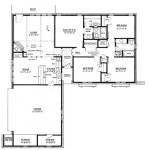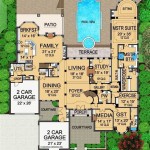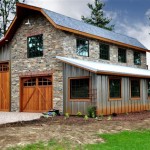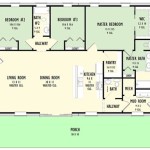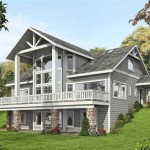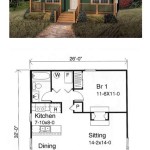Modern Eco-Friendly House Plans: Designing for a Sustainable Future
The confluence of escalating environmental concerns and technological advancements has ushered in a new era of residential design, characterized by modern eco-friendly house plans. These plans prioritize energy efficiency, resource conservation, and the creation of healthy indoor environments, ultimately reducing the ecological footprint of the built environment and enhancing the well-being of residents. This article explores the key elements defining modern eco-friendly house plans, highlighting the design principles, material choices, and technological integrations that contribute to a sustainable and comfortable living space.
Passive Design Strategies: Maximizing Natural Resources
Passive design strategies form the bedrock of any effective eco-friendly house plan. These strategies leverage natural resources, such as sunlight, wind, and geothermal energy, to minimize the need for mechanical heating, cooling, and lighting systems. Implementing passive design principles requires a thorough understanding of the site's climate, orientation, and surrounding landscape.
One fundamental aspect of passive design is solar orientation. Orienting the house to maximize southern exposure in colder climates allows for optimal solar heat gain during the winter months, reducing reliance on heating systems. Conversely, in warmer climates, strategic shading and orientation can minimize direct sunlight exposure, preventing overheating during the summer. Overhangs, awnings, and strategically planted trees can provide effective shading, reducing the need for air conditioning.
Natural ventilation is another crucial element of passive design. Designing a house to facilitate cross-ventilation allows for the natural flow of air, cooling the interior and improving indoor air quality. Properly positioned windows and doors, along with strategically placed vents, can create a natural breeze throughout the house. The stack effect, where warm air rises and exits through high windows or vents, can further enhance natural ventilation.
Thermal mass plays a vital role in regulating indoor temperatures. Materials with high thermal mass, such as concrete, brick, and stone, can absorb and store heat during the day, releasing it slowly at night, thus moderating temperature fluctuations. Incorporating thermal mass strategically, such as in floors and walls exposed to direct sunlight, can significantly reduce the need for heating and cooling systems.
Daylighting, the use of natural light to illuminate interior spaces, is a key component of passive design. Maximizing natural light reduces the need for artificial lighting, saving energy and creating a more pleasant indoor environment. Large windows, skylights, and light tubes can be used to bring natural light into the house. Careful consideration should be given to window placement to avoid glare and overheating. Light shelves and reflectors can also be used to distribute light more evenly throughout the space.
Sustainable Materials: Prioritizing Environmental Responsibility
The selection of sustainable materials is paramount in creating an eco-friendly house. Sustainable materials are those that have a low environmental impact throughout their life cycle, from extraction and manufacturing to transportation, installation, and disposal. Choosing materials that are renewable, recycled, or locally sourced can significantly reduce the environmental footprint of the house.
Renewable materials, such as bamboo, wood certified by the Forest Stewardship Council (FSC), and cork, are harvested from sustainably managed sources. These materials are readily replenished and have a lower impact on ecosystems compared to non-renewable materials. Bamboo, for example, is a fast-growing grass that can be harvested in a few years, making it a highly renewable resource. FSC-certified wood ensures that forests are managed responsibly, protecting biodiversity and preventing deforestation.
Recycled materials, such as recycled glass, recycled plastic, and recycled metal, reduce the demand for virgin resources and divert waste from landfills. These materials can be used in a variety of applications, from flooring and countertops to insulation and structural components. Recycled glass countertops, for example, are made from crushed recycled glass and cement, offering a durable and aesthetically pleasing option.
Locally sourced materials reduce the environmental impact of transportation and support local economies. Using materials that are produced within a reasonable distance of the construction site minimizes the carbon emissions associated with transportation. Sourcing materials locally also supports local businesses and creates jobs in the community.
Low-VOC (volatile organic compound) materials are essential for creating a healthy indoor environment. VOCs are chemicals emitted by many conventional building materials, such as paints, adhesives, and flooring. These chemicals can contribute to indoor air pollution and cause health problems. Choosing low-VOC materials minimizes the emission of these harmful chemicals, improving indoor air quality and protecting the health of residents.
Insulation is a critical element of any eco-friendly house. Proper insulation reduces heat loss in the winter and heat gain in the summer, minimizing the need for heating and cooling systems. Sustainable insulation materials, such as recycled denim, sheep's wool, and cellulose, offer excellent thermal performance and are made from renewable or recycled resources. These materials are also often treated to resist pests and fire.
Energy-Efficient Technologies: Enhancing Performance and Reducing Consumption
Integrating energy-efficient technologies into the house plan is crucial for minimizing energy consumption and reducing the environmental impact. These technologies can significantly improve the performance of the house, making it more comfortable, sustainable, and cost-effective to operate.
Solar panels are a popular and effective way to generate renewable energy. Solar panels convert sunlight into electricity, which can be used to power the house. Surplus electricity can be fed back into the grid, earning credits for the homeowner. Solar panels can be integrated into the roof or walls of the house, or they can be installed on a separate structure, such as a carport or pergola.
High-efficiency appliances, such as refrigerators, washing machines, and dishwashers, consume significantly less energy than standard appliances. Look for appliances with the Energy Star label, which indicates that they meet strict energy efficiency standards. Replacing older appliances with high-efficiency models can significantly reduce energy consumption and save money on utility bills.
Smart home technology can help to optimize energy consumption and improve convenience. Smart thermostats can automatically adjust the temperature based on occupancy and time of day, reducing energy waste. Smart lighting systems can automatically turn off lights in unoccupied rooms. Smart irrigation systems can automatically adjust watering schedules based on weather conditions, conserving water. Smart meters provide real-time data on energy consumption, allowing homeowners to track their usage and identify areas for improvement.
Energy-efficient windows and doors are essential for minimizing heat loss and gain. Double-paned or triple-paned windows with low-E coatings can significantly reduce heat transfer. Proper sealing around windows and doors prevents drafts and further reduces energy loss. Energy-efficient doors with insulated cores provide additional protection against heat loss.
Water conservation technologies are also important for creating an eco-friendly house. Low-flow toilets, showerheads, and faucets reduce water consumption without sacrificing performance. Rainwater harvesting systems can collect rainwater from the roof and store it for use in irrigation or toilet flushing. Greywater systems can recycle water from showers and sinks for use in irrigation. Implementing these technologies can significantly reduce water consumption and conserve this valuable resource.
Geothermal heat pumps utilize the earth's constant temperature to heat and cool the house. These systems are highly efficient and can significantly reduce energy consumption compared to conventional heating and cooling systems. Geothermal heat pumps can be used in both cold and warm climates, providing a reliable and sustainable source of heating and cooling.
LED lighting is significantly more energy-efficient than incandescent or fluorescent lighting. LED bulbs consume up to 80% less energy and last much longer, reducing the need for replacements. LED lighting also produces less heat, further reducing energy consumption. Switching to LED lighting throughout the house can significantly reduce energy bills and improve the overall energy efficiency of the house.
Proper ventilation systems, such as energy recovery ventilators (ERVs) and heat recovery ventilators (HRVs), can improve indoor air quality while minimizing energy loss. These systems exchange stale indoor air with fresh outdoor air, while recovering heat or energy from the exhaust air. ERVs and HRVs can significantly improve indoor air quality and reduce energy consumption, especially in tightly sealed houses.
The integration of these passive design strategies, sustainable materials, and energy-efficient technologies results in modern eco-friendly house plans that are not only environmentally responsible but also comfortable, healthy, and cost-effective to operate. These plans represent a significant step towards creating a sustainable future for the built environment.

Eco Friendly Home Plans House Design

Eco House Plans Friendly Design Narrow

Eco Houses 7 Most Beautiful Sustainable Builds From Forest Dwellings To City Homes Gardens

Eco Friendly Home Designs Salter Spiral Stair

6 Incredible Eco Friendly House Ideas Completehome

The Top 10 Sustainable Home Design Trends

Eco Friendly House Plans Green Energy Star Rated The Designers

Take One Of These Modern Eco Friendly Portable Homes Anywhere With You House Architecture Design

Eco Friendly Home Design In Toronto A Window With Waterfall Effect

10 Eco Friendly Homes With Dreamy Interiors You Ll Want To Hide Away In Forever

